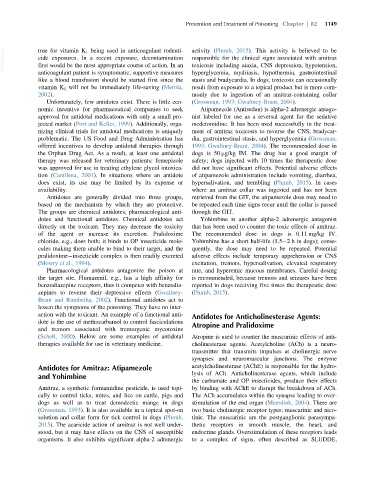Page 1218 - Veterinary Toxicology, Basic and Clinical Principles, 3rd Edition
P. 1218
Prevention and Treatment of Poisoning Chapter | 82 1149
VetBooks.ir true for vitamin K 1 being used in anticoagulant rodenti- activity (Plumb, 2015). This activity is believed to be
responsible for the clinical signs associated with amitraz
cide exposures. In a recent exposure, decontamination
toxicosis including ataxia, CNS depression, hypotension,
first would be the most appropriate course of action. In an
anticoagulant patient is symptomatic, supportive measures hyperglycemia, mydriasis, hypothermia, gastrointestinal
like a blood transfusion should be started first since the stasis and bradycardia. In dogs, toxicosis can occasionally
vitamin K 1 will not be immediately life-saving (Merola, result from exposure to a topical product but is more com-
2002). monly due to ingestion of an amitraz-containing collar
Unfortunately, few antidotes exist. There is little eco- (Grossman, 1993; Gwaltney-Brant, 2004).
nomic incentive for pharmaceutical companies to seek Atipamezole (Antisedan) is alpha-2 adrenergic antago-
approval for antidotal medications with only a small pro- nist labeled for use as a reversal agent for the sedative
jected market (Post and Keller, 1999). Additionally, orga- medetomidine. It has been used successfully in the treat-
nizing clinical trials for antidotal medications is uniquely ment of amitraz toxicosis to reverse the CNS, bradycar-
problematic. The US Food and Drug Administration has dia, gastrointestinal stasis, and hyperglycemia (Grossman,
offered incentives to develop antidotal therapies through 1993; Gwaltney-Brant, 2004). The recommended dose in
the Orphan Drug Act. As a result, at least one antidotal dogs is 50 μg/kg IM. The drug has a good margin of
therapy was released for veterinary patients: fomepizole safety; dogs injected with 10 times the therapeutic dose
was approved for use in treating ethylene glycol intoxica- did not have significant effects. Potential adverse effects
tion (Cantilena, 2001). In situations where an antidote of atipamezole administration include vomiting, diarrhea,
does exist, its use may be limited by its expense or hypersalivation, and trembling (Plumb, 2015). In cases
availability. where an amitraz collar was ingested and has not been
Antidotes are generally divided into three groups, retrieved from the GIT, the atipamezole dose may need to
based on the mechanism by which they are protective. be repeated each time signs recur until the collar is passed
The groups are chemical antidotes, pharmacological anti- through the GIT.
dotes and functional antidotes. Chemical antidotes act Yohimbine is another alpha-2 adrenergic antagonist
directly on the toxicant. They may decrease the toxicity that has been used to counter the toxic effects of amitraz.
of the agent or increase its excretion. Pralidoxime The recommended dose in dogs is 0.11 mg/kg IV.
chloride, e.g., does both; it binds to OP insecticide mole- Yohimbine has a short half-life (1.5 2 h in dogs); conse-
cules making them unable to bind to their target, and the quently, the dose may need to be repeated. Potential
pralidoxime insecticide complex is then readily excreted adverse effects include temporary apprehension or CNS
(Mowry et al., 1994). excitation, tremors, hypersalivation, elevated respiratory
Pharmacological antidotes antagonize the poison at rate, and hyperemic mucous membranes. Careful dosing
the target site. Flumazenil, e.g., has a high affinity for is recommended, because tremors and seizures have been
benzodiazepine receptors, thus it competes with benzodia- reported in dogs receiving five times the therapeutic dose
zepines to reverse their depressive effects (Gwaltney- (Plumb, 2015).
Brant and Rumbeiha, 2002). Functional antidotes act to
lessen the symptoms of the poisoning. They have no inter-
action with the toxicant. An example of a functional anti- Antidotes for Anticholinesterase Agents:
dote is the use of methocarbamol to control fasciculations Atropine and Pralidoxime
and tremors associated with tremorgenic mycotoxins
(Schell, 2000). Below are some examples of antidotal Atropine is used to counter the muscarinic effects of anti-
therapies available for use in veterinary medicine. cholinesterase agents. Acetylcholine (ACh) is a neuro-
transmitter that transmits impulses at cholinergic nerve
synapses and neuromuscular junctions. The enzyme
Antidotes for Amitraz: Atipamezole acetylcholinesterase (AChE) is responsible for the hydro-
lysis of ACh. Anticholinesterase agents, which include
and Yohimbine
the carbamate and OP insecticides, produce their effects
Amitraz, a synthetic formamidine pesticide, is used topi- by binding with AChE to disrupt the breakdown of ACh.
cally to control ticks, mites, and lice on cattle, pigs and The ACh accumulates within the synapse leading to over-
dogs as well as to treat demodectic mange in dogs stimulation of the end organ (Meerdink, 2004). There are
(Grossman, 1993). It is also available in a topical spot-on two basic cholinergic receptor types: muscarinic and nico-
solution and collar form for tick control in dogs (Plumb, tinic. The muscarinic are the postganglionic parasympa-
2015). The acaricide action of amitraz is not well under- thetic receptors in smooth muscle, the heart, and
stood, but it may have effects on the CNS of susceptible endocrine glands. Overstimulation of these receptors leads
organisms. It also exhibits significant alpha-2 adrenergic to a complex of signs, often described as SLUDDE,

